|
The first few days of our trip were spent in and around Jerusalem. Our intent was to explore the possibilites of achieving peaceful coexistence among the many different people who live in Israel, and we quickly started identifying obstacles to that goal. One recurring hazard is that the very words you use can divide people before you even start to discuss a topic.
For example: what do you call this geographic area? What I write here is my own very brief summary of complex events, and you can easily find scholarly books and in-depth analyses of the subject that either parallel my summary or completely contradict it. With that caveat, here goes: Israel declared itself a nation in 1948; many other nations in the world recognize that it legitimately exists, but some of its close neighbors refuse to acknowledge it and remain at war with it. Immediately before Israel was born, the area was under British control, and Britain was tasked with dividing the region into separate homelands for Jews and Muslims. The Jews became self-governing within the borders of Israel, and the Kingdom of Jordan took charge of the area that had been identified as intended for a new Muslim nation. This new Muslim nation was not created, however; instead, Jordan remained in control of an area that, from Jordan's perspective, was the West Bank of the Jordan River, including the eastern part of the city of Jerusalem. Thus, the name "West Bank" entered common use.
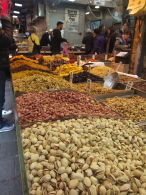 |
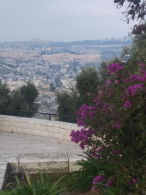 |

|
|
Mahane Yehuda Market |
View of the Old City of Jerusalem |
SW corner of the Temple Mount Wall |
In 1967 came the Six-Day War. Again, you can easily find descriptions of the conflict from multiple perspectives. The practial result was that, after six days, Israel controlled a united Jerusalem and all of what had been the West Bank. From Israel's perspective, they were going to occupy this area until a secure peace could be negotiated and a new, self-governing Muslim nation established, giving the world a new name to use: the "Occupied Territories".
But the divisions within Israel are not simply between Jew and Muslim. There are different kinds of Jews and different kinds of Muslims. In part, Jews include the ultra-Orthodox, Modern Orthodox, Masorti (equivalent to America's Conservative movement), Reform, and secular. Muslims might be Arab-Israelis, Druse, Bedouin, Circassian, Palestinian, or others. Religious identity is not simple...(and I won't get into the multitudinous branches of Christianity, because Christians currently are a tiny and not very influential minority within the geopolitical mosaic of the region).
I mention religious pluralism here because an influential subset of Jews believe that the modern nation of Israel should encompass all of the land described in the Bible as being part of ancient Israel. That includes areas called Judea and Samaria...which are in the Occupied Territories. Which gives us another name: the "Disputed Territories". Many Jewish settlements have been built by people who consider it their God-given right to live anywhere and everywhere within "The Land". At the same time, Muslims who still aspire to have their own, self-governing and independent nation want that same geographic region for their home.
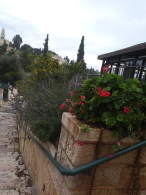 |
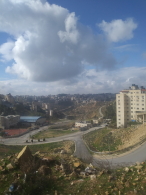 |
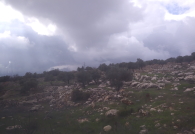
|
|
Yemin Moshe neighborhood |
Ramallah |
Ancient olive trees |
We started our stay in Jerusalem with a tour of the Mahane Yehuda market, tasting examples of hummus and pita and discussing the practicality of identifying foods as exclusively "Jewish" or "Arab" or "Muslim" when, quite often, they are simply common to a whole region because certain crops grow there and, over centuries and millenia, neighboring cultures develop "fusion" cuisines. During the next few days, the weather was cool and rainy, but we heard talks about the complex efforts to unify Jerusalem, and the tensions between the ultra-Orthodox and other Jews, and visited, among other places, the Davidson Archeological Park and the Bilal fabric shop in the Old City (run by the same Muslim family for several generations), which sells imported Syrian fabric to Hasidic Jews, Muslim imams, and Christian clergy.
We also spent an entire day in the Territories, with extended stops in Ramallah, a Jewish settlement called Psagot, and a new Palestinian city named Rawabi. We listened to an American-Palestinian businessman describe his frustrations with trying to build a modern tech business in Ramallah, and learned about the complex security and civic governance situation in the Territories. In some areas, the Palestinian Authority has complete responsibility for infrastructure (power, water, garbage collection, social services, etc.) plus security (local police). In other areas, Israel assumes complete control for all those things, and in yet other areas, the duties are shared. As you can imagine, a patchwork quilt of "who's in charge here?" does not contribute to day-to-day efficiency. Finally, we met with several of the people developing the new Palestinian city of Rawabi, a planned community that will eventually include industry, entertainment, and housing for close to 50,000 people.
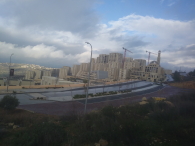 |
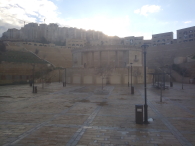 |
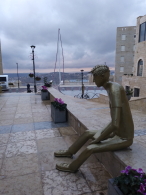
|
|
Rawabi, with mosque under contruction |
Rawabi amphitheater |
Shopping mall, at the top of Rawabi |
Our days in Jerusalem and the Territories gave us a taste of the area's history, and a sobering look at some of the challenges facing the country and its people. However, we also started seeing just how many individuals and organizations are seeking ways to solve the problems. If you'd like to read more, here are a few interesting websites:
Next: The Kinneret
|